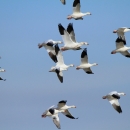Featured Species
Waterfowl:
Washita serves as a winter resting area for four species of geese and 22 species of ducks. Canada geese, snow geese, Ross’s geese, and greater white-fronted geese gather in great numbers at the refuge, resting by night on the waters of Foss Lake and feeding by day on area farm fields. Winter of 2011 saw a record number of geese on the refuge, with 144,970 geese counted as they flew from their roost on Foss Lake! The most common ducks found here are the mallard, American wigeon, gadwall, northern pintail, ring-necked duck, redhead, and hooded merganser. Ducks are often found foraging in the refuge’s moist soil units or floating on the waves on Foss Lake.
Resident Wildlife:
White-tailed deer, Rio Grande wild turkeys, red-tailed hawks, coyotes and bobcats are just some of the species that call the refuge home all year long. Resident wildlife species are animals that don’t migrate to other places to escape the cold winters or find better places to raise their young. They live on the refuge and surrounding area all year, and depend on the western Oklahoma habitat to meet all their needs, including shelter from winter storms, water for their daily lives and shade from the blazing summer sun.
Habitat:
Washita National Wildlife Refuge encompasses more than 8,000 acres of rolling prairie, woodlands, farm fields, mud flats, marshes, and open water. The refuge is located in the transition zone between shortgrass and tallgrass prairies, and has grass species including buffalo grass, little bluestem, big bluestem, and indiangrass. Western soapberry trees and black locusts form small groves on the landscape, and the winding Washita River provides water to fill Foss Lake. This variety of habitats provides homes for a diverse array of wildlife. So far, 271 species of bird, 46 species of mammals, 39 species of reptiles, and 11 species of amphibians have been found on or around Washita National Wildlife Refuge.







